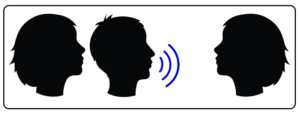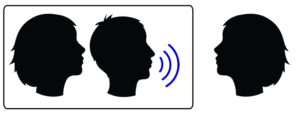July 7, 2018
“We” in Chamorro

The pronoun “we” in English can sometimes be ambiguous if the sentence is not constructed carefully. When it is used in conversation sometimes it is unclear if the person being spoken to is included in this mention of “we.” This ambiguity does not exist in Chamorro as there are two versions of “we”, defined as inclusive, meaning the addressee is included, and exclusive, the addressee is excluded.
The Inclusive/Exclusive “we” in Chamorro
Look at the sentence below and then look at the diagrams.
Speaker: Para ta fanhånao para i tasi! / We’re going to beach!
In Figure 1, the speaker is letting the other person know they’re included in the activity.
Speaker: Para bai in hanao para i tasi! / We’re going to the beach!
In Figure 2, the speaker is letting the other person know his plans.
A “We” for every situation
Once you’ve learned and are able to distinguish between the two “we”s in Chamorro, you can start learning the different words for them. The word for we changes depending on what you want to say.
Stative / Intransitive Sentence
A stative sentence is a basic sentence consisting of a subject and a predicate and is usually a descriptive sentence. For example, “We are happy” is a stative sentence. An intransitive sentence in Chamorro is one where there is no definite object involved. The Chamorro words for we here are inclusive hit and exclusive ham.
Chamorro ham.
We are Chamorro.
Chamorro hit.
We are Chamorro.
Chumocho ham.
We ate.
Mañocho hit gi resturan.
We ate at the restaurant.
Transitive Sentence with Definite Object
You may have noticed that the above sentence examples have the subject pronoun AFTER the verb. When a definite (specific) object is involved, the sentence structure changes to a structure familiar to English speakers: Subject Verb Object.
For example, in the sentence “He ate the apple”, the word “he” is the subject, “ate” is the verb, and “the apple” is the object. In Chamorro, the structure will be exactly the same. Except, here’s the catch, this only applies if the object is a definite object, that is, the object is specific. Our example works because the object “the apple” is specific; the apple refers to a specific apple located somewhere or bought by someone. If our example had been “He ate an apple,” then our sentence structure would revert back to Verb Subject, since there is no definite object involved.
The words for we in this sentence construction are inclusive ta and exclusive in.
In faisen si George.
We asked George.
Ta faisen si George.
We asked George.
Actor-focus Constructions
In English, the way someone emphasizes that the subject is responsible for an action is by adding the words “is the one who” or by putting stress on the subject when mentioning them verbally.
For example:
We ate the pizza. vs. We (were the ones who) ate the pizza OR We at the pizza.
To achieve the same thing in Chamorro, we use Actor-focus constructions and Emphatic pronouns. By themselves, the pronouns for the first-person plural are understood as US instead of WE, but are understood as WE in Actor-focus constructions. The emphatic we are the inclusive hita and exclusive hami.
Hami! Us! (Not you!)
Hita! Us! (Including you!)
Hami chumule’ i lamasa siha.
We (are the ones who) brought the tables.
Now that you’ve figured out there’s more to “WE” in Chamorro, you’re probably thinking you’re done, right? Well, not so fast. If you haven’t checked it out already, here’s how to say the singular and plural “you” in Chamorro.

